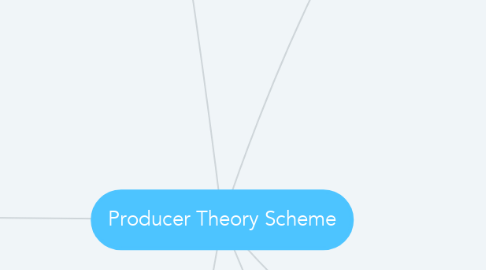
1. Topic 10. Perfect Competence
1.1. Important supositions and conditions
1.1.1. Suppositions
1.1.2. Conditons to maximize benefit
1.1.2.1. Max pi= p*q - TC(q)
1.1.2.2. P=mgC(Q)
1.1.2.3. MgC’(Q)>0
1.1.2.4. Shutdown condition
1.1.2.4.1. No shutdown
1.1.2.4.2. Shutdown
1.2. Short term analysis
1.2.1. Supply on the short term
1.2.1.1. S(p) = 0 if p< min AVC(shutdown)
1.2.1.2. S(p) p=CMg(Q) if p>min AVC
1.2.2. Relevant prices
1.2.3. Steps for performing practical exercises
1.2.3.1. 1. Calculate individual supplies: clear Q from p=MgC(Q)
1.2.3.2. 2.Market supply Qag = SUMATORIE Qi -> Aggregate Q
1.2.3.3. 3.Equal agregate supply to aggregate demand: S(p)=D(p)
1.2.4. Short term possibilities
1.2.4.1. P<Min AVC
1.2.4.1.1. Business don’t produce
1.2.4.1.2. Business produce with losses
1.2.4.2. Min AVC<P<Min ATC
1.2.4.3. P>Min ATC
1.2.4.3.1. Business produce without losses
1.3. Short/Long term relationship
1.3.1. Short
1.3.1.1. P<0 business exit
1.3.1.2. P=0 Business mantain
1.3.1.3. P>0 Businesses enter
1.3.2. Long
1.3.2.1. Nule benefit
1.3.2.1.1. P= min ATC(Q)
1.4. Long term Analysis
1.4.1. Supply on the long term
1.4.1.1. S(p)=0 if p<min AC
1.4.1.2. S(P) p=MgC(Q) if p>min AC
1.4.1.3. No fixed cost
1.4.2. Steps for solving exercises
1.4.2.1. Plan and minimize the average cost. Obtain Qe
1.4.2.2. Inserting the Qe into AC we obtain the price = min AC
1.4.2.3. Insert the price into the demand function and obtain Qt
1.4.2.4. nº businesses= Qt/Qe
1.5. Practice
1.5.1. Most common test questions
1.5.2. Most common practical questions
2. Topic 11. Monopoly
2.1. Conditions
2.1.1. Basic Suppositions
2.1.2. Condition of maximum benefit for the monopolist
2.1.2.1. B(Q)=I(Q)-C(Q)=p(q)*q-C(Q)
2.1.2.2. Steps for maximizing benefit
2.1.2.2.1. FOC. dB/dQ=0
2.1.2.2.2. SOC=d2B/dq2<0
2.1.3. Conditions of economical viability
2.1.3.1. Short term
2.1.3.1.1. P>=AVC
2.1.3.2. Long term
2.1.3.2.1. P>=AC
2.2. Monopolistic Market
2.2.1. The ausence of a supply curve in the monopoly
2.2.1.1. The quantity offered is determined by the intersection between Marginal costs and Marginal revenue
2.2.1.2. Price is established by demand curve
2.2.2. How to obtain the monopolist equilibrium
2.2.2.1. MgR=MgC to maximize benefit
2.2.2.2. Calculate the price substituting the monopolist q in the demand
2.2.3. Excedents and loss of wellness provoked by monopoly
2.2.3.1. Consumer excedent
2.2.3.2. Producer excedent
2.2.3.2.1. PE=I(q*)-CV(q*)
2.2.3.2.2. PE=B(q*)+FC
2.2.3.3. Total excedent
2.2.4. Relation between marginal revenue and elasticity
2.2.4.1. MgR=P(q)(1+1/e(q,p)) MgR=P(q)(1-1/|e(q,p)|)
2.2.4.2. MgR>0 if |e(p,q)|>1 MgR=0 if |e(p,q)|=1 MgR<0 if |e(p,q)|<1
2.2.4.3. A monopolist always maximizes benefits at the elastic place of the demand
2.2.5. Lerner index
2.2.5.1. l=(p(q)-mgC)/p(p)
2.2.5.1.1. I=-1/e(p,q)
2.2.5.1.2. I=1/ |e(p,q)|
2.3. Price discrimination in the monopoly
2.3.1. First grade discrimination
2.3.2. Second Grade discrimination
2.3.3. Third grade discrimination
2.3.3.1. B(q)= R(Q1)+R(Q2)-C(Qt)
2.3.3.1.1. MgR1=MgC MgR2=MgC
2.3.4. Solving a price discrimination Problem
2.3.4.1. 1.Obtain MgR1=MgC and MgR2=MgC
2.3.4.1.1. 2.Solve q and calculate total quantity
2.4. Regulation of Monopolies
2.4.1. Regulation of the eficient quantity of the monopoly
2.4.1.1. P=MgC
2.4.2. Social Monopolies, nule benefit regulation
2.4.2.1. P=AC
2.5. Natural monopolies
2.6. Practice
2.6.1. Most common test questions
2.6.2. Most common practical questions
3. Most Common questions Analysis For practice
3.1. Which practice question is more common(From 1-10)
3.1.1. From Topic 8
3.1.2. From Topic 9
3.1.3. From Topic 10
3.1.4. From Topic 11
3.2. Meet Google Drive – One place for all your files
3.3. Previous partials
3.4. Class exercises
3.4.1. https://drive.google.com/drive/folders/1qRFBt0B_QqzGFuP5x3kg06_ne-_utqju?usp=sharing
4. Types of economies of scale
4.1. With a technological origin
4.2. With a pecunarie origin
4.3. Economie of scale=! Performance by scale. Performance of scale->Economies of scale
5. Topic 8.Producer theory. Production Function
5.1. Isoquants and RMST
5.1.1. Inputs
5.1.1.1. Capital(K)
5.1.1.2. Labor(L)
5.1.2. Isoquants=Q=f(L,K)
5.1.3. RMST=PmgL/PmgK=(dQ/dL)/(dQ/dK)
5.1.4. Productivity
5.1.4.1. Marginal Productivity=dQ/dL(of Labor) dQ/dK(of Capital)
5.1.4.2. Average Productivity= PMeL=Q/L PMeK=Q/K
5.2. Scale Performance
5.2.1. Increasing Scale Performance
5.2.2. Constant Scale Performances
5.2.3. Decreasing Scale Performance
5.3. Analysis Short term vs Long term
5.3.1. Short term
5.3.1.1. Q=f(l)
5.3.1.2. Marginal and average productivity can be easily represented
5.3.2. Long term
5.3.2.1. Cobb Douglas
5.3.2.1.1. U=AL^aK^b/U=ln(L) + ln(K)
5.3.2.1.2. RMST= aK/bL
5.3.2.2. Perfect Complements
5.3.2.2.1. Q= a MIN{aL,bK}
5.3.2.2.2. RMST cannot be calculated
5.3.2.3. Perfect Substitutes
5.3.2.3.1. Q=(aL+bK)^c
5.3.2.3.2. RMST = a/b
5.3.2.4. Quasilineal
5.3.2.4.1. Three cases for demand
5.3.2.4.2. Q=f(L)+f(K)
5.4. Monotone increasing transformations
5.5. Exercises types
5.5.1. Test questions
5.5.2. Most common exam questions
6. Topic 9. Functions of Costs
6.1. Cost functions in the Short term
6.1.1. 1.Substitute fixed factor in the production function and clear the variable function.
6.1.1.1. We obtain the conditioned demand of the factor
6.1.2. 2.Compute the conditioned demands in the isocost function
6.1.2.1. C=wL+rK-> TC(w,r,Q)
6.2. Cost functions in the Long term
6.2.1. An optimization problem. 1.-Min C=wL + rK 2.-s.a. Q= f(L,K)
6.2.1.1. 1.|RMST|=w/r. 2. Q=F(L,K)
6.2.1.1.1. Ld=f(w,r,Q) Kd=f(w,r,Q)
6.2.1.2. Interior and exterior solutions
6.2.1.2.1. Interior
6.2.1.2.2. Exterior
6.3. Cost Concepts(Average cost and marginal cost)
6.3.1. Short Term
6.3.2. Long Term
6.3.2.1. Long term costs <= Short term costs
6.3.3. Graphical analysis of cost
6.4. Economies and diseconomies of scale
6.4.1. Economies of scale
6.4.2. Constant scale economies
6.4.3. Diseconomies of scales
6.5. Exercises
6.5.1. Test questions
6.5.2. Most common exam questions
